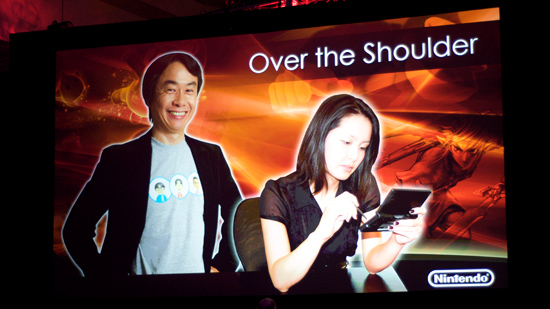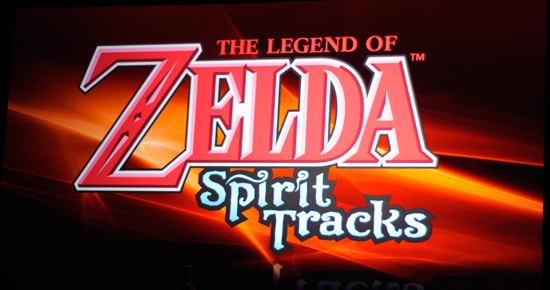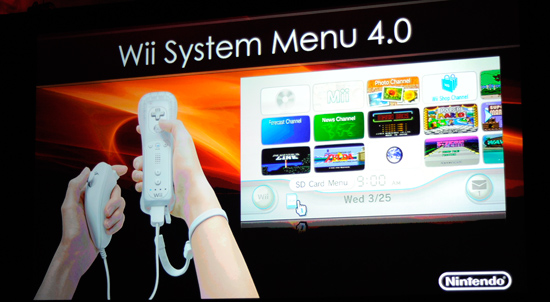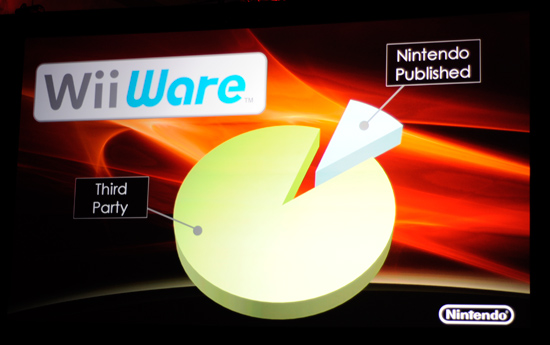Nintendo's Development Secrets, Cloud Gaming & new Killer NIC - GDC '09
by Anand Lal Shimpi & Derek Wilson on March 26, 2009 12:00 AM EST- Posted in
- Trade Shows
The Two Most Hilarious Miyamoto Pictures
Before I get off the Miyamoto topic entirely I want to share two things that transpired during the keynote. First, Nintendo’s president talked about how Miyamoto engages in random employee kidnapping. He grabs an employee at random from the halls of Nintendo and makes him/her play one of these games in production. The employee doesn’t give any feedback; there are no forms or anything else formal, he/she just has to play the game and have fun - if that’s possible. It’s a very back-to-basics approach to game development that I believe is sometimes lost among everything that a developer needs to worry about.

Awesome?
How does Miyamoto get feedback on the user’s experience with the game? Well he uses a over-the-shoulder approach to watching the user of course:

He made Mario
Yep.
Wii System Menu 4.0
While I don’t want my first article about GDC to be a complete Nintendofest, it’s worth talking about some of the improvements that Nintendo announced at the show. There were no major game releases and no real hardware improvements, just minor evolutionary enhancements to the Wii’s OS.

We did get word of a new Zelda title for the DS in 2009
The Wii System Menu 4.0 adds support for SD-HC cards (2GB - 32GB in size) - thus allowing you to store more game data on a single SD card in your Wii. You can also store entire WiiWare games (downloadable Wii titles) on your SD card. Previously you could only store downloadable games and content on the Wii’s internal flash, which is only 512MB in size.

You can launch games directly from the SD card now too, and the system update is available today.
Third Party Development Doesn’t Suck on the Wii, I Swear!
Despite his comforting demeanor, Iwata’s keynote was a bit self serving. He very much wanted to convey the message that the Wii is good for 3rd party game developers, and that it’s not simply a cash cow for Nintendo.

Look! The majority of WiiWare games are 3rd party titles.
That’s what the whole spiel about the Wii having such a large installed user base was designed to do. Iwata said that Nintendo had to work hard to build such a large user base and that now 3rd party developers can benefit from so many existing Wii systems in the market.
The reality of the matter is that installed user base doesn’t necessarily translate into very high game sales numbers, especially if you’re not Nintendo. There are tons of problems and lots of blame to pass around when it comes to developing on the Wii. It’s difficult to compete with Nintendo and the Wii doesn’t have powerful enough hardware to just port your Xbox 360/PS3 games over. On the flip side, there are more Wii consoles in the market than Xbox 360s or PS3s so it makes sense to put in some extra effort into making a Wii-specific game.
Nintendo says that 3rd party developers can succeed on the Wii. Some developers disagree. I figure the reality of the situation is somewhere in between there.










38 Comments
View All Comments
wilkinb - Thursday, March 26, 2009 - link
in woW latency can be a big deal...Stop casts in pvp or boss fights are a lot harder when you have high ping times and the cast times are short....
Also timing CD's right time not be on shot...
Sure if you are just doing easy content or dont care about arenas then it doesnt matter... but the same can be said about FPS...
Also people keep saying wow isnt prashically intensive.. this again is true when you stand by your self... when you are on say a WG battle ground with say 160 other players adn all their spell effects... there are a lot of polygons... It runs slower then crysis for example.
MOO's have to deal with more scaling issues then FPS.
MMO's have the issue f
wilkinb - Thursday, March 26, 2009 - link
no idea what happned to some of that text :(wtb edit.
randomname - Thursday, March 26, 2009 - link
"I'm sure the video latency will be at least a second."In Dean Takahashi's article:
"A packet can make an entire round trip in 80 milliseconds, a very short amount of time compared to other Internet traffic that travels through hardware that either compresses or decompresses the data."
I'm assuming that 80 ms has all the essential stages included. Which would be supported by Anand's claim that Bioshock felt like Bioshock.
Nevertheless, lag, reliability and bandwidth are probably the only obstacles here. All of which can be further improved. Bandwidth-wise, once you get to Blu-Ray -quality 40/48 Mbps, or at least when you get to 1080p60 4:4:4 -quality, additional bandwidth won't get you anything, really. On the server side, you would only have to buy a fraction of the number of consoles/computing hardware compared to every user buying one. And if you can do it with games, you can do it with all programs and media.
SSDMaster - Thursday, March 26, 2009 - link
80ms? Okay, wonderful. I have to wait .08 Seconds till I can move my cross hairs over someone's head which is only going to be in that specific location for another .02 Seconds.FPS's are too fast paced for this... Especially UT 2004 types.
Maybe you could play a horrendously slow paced FPS like Halo or something.
Also, the US internet backbone just cannot handle this kind of streaming. Comcast gives me a 30mb connection for about 7 minutes. Then they cap it back to whatever I "really" have, which is a 6mb connection. Which "should" be enough unless everyone starts using onLive... Then I'm sure Comcast won't even be able to give me 6mb.
My last point. Internet packets don't always arrive on time or in order, its not like you have this one internet (pipe) to your computer. Think of a stream full of rocks, and your packets (water) are taking tons of different paths, all around these rocks.
That's really not a good enough illustration but I think you guys get the point. If you have a router between you and onLive server's which is bogged down but still working; then your connections going to suck. Not all routers prioritize packets.
Modeverything - Thursday, March 26, 2009 - link
I think one solution to this could be to use UDP instead of TCP.Today's networks are not the ones of a decade ago when packet verification was needed. Packets rarely get lost anymore, and if you lose a single packet, big deal, you probably won't notice anyway.
If OnLive were setup to use UDP transmission, I think it would work.
overzealot - Friday, March 27, 2009 - link
It's a latency-critical app, they're definately going to use UDP, possibly with a layer of RTP(or similar protocol)andrihb - Thursday, March 26, 2009 - link
Think of them as a series of...Calin - Thursday, March 26, 2009 - link
Latency might not be a big deal in World of Warcraft - but remember that people balk at the idea of TFT monitors showing the image from 3-5 frames back - that's less than a tenth of a second. If you're talking about Internet-enabled gaming, you should consider the ping response time you get from a server when you're streaming something (from the same server, probably). Let's say ping to a game server while streaming high quality video.The bandwidth really needs to increase for this, and the latency needs to go down.
As for adaptive quality based on usable bandwidth, you don't know when you're reaching your bandwidth, you only know when you're surpassing it, so that makes the game stutter (too low a bandwidth = lost packets), then go sometime in low quality mode, and then go again in high quality mode. For high quality games, the server would need the equivalent of a high-performance recent-generation video card and CPU for every gamer out there, and the hardware or CPU to compress that stream (video and audio)
It will probably happen, but it's a long time into future